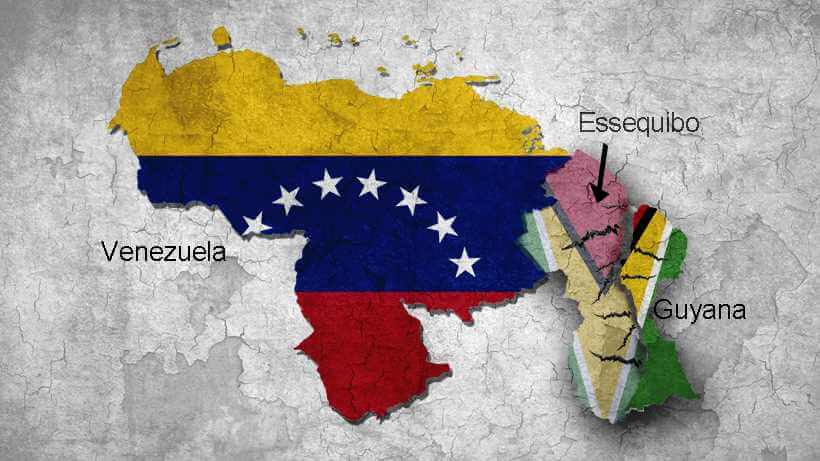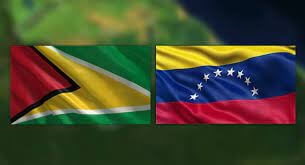Border Dispute

Venezuela claims large chunks of Guyana
eyesonsuriname /Ivelaw Lloyd Griffith
Amsterdam, August 31st 2022– The ongoing controversy between Guyana and Venezuela, is set in the context of a famous stage play. It discusses some new dynamics of the judicial pursuits, including, notably, Venezuela’s new moves.
Settlement of the Guyana-Venezuela territorial controversy evokes memories of the award-winning play Waiting for Godot by the famous Irish playwright Samuel Beckett. In the play two characters, Didi and Gogo, engage in interminable conversations near a leafless tree while waiting for another character named Godot, who never arrived.
The game begins

The waiting game dates to February 1962, when Venezuela first formally challenged the validity of the 1899 Paris Arbitral Award, informing the United Nations Secretary-General that it considered a dispute to exist over the demarcation of the frontier with the then colony of British Guiana. Venezuela contended that “The award was the result of a political transaction carried out behind Venezuela’s back and sacrificing its legitimate rights. The frontier was demarcated arbitrarily, and no account was taken of the specific rules of the arbitral agreement or of the relevant principles of international law. Venezuela cannot recognise an award made in such circumstances.”
After several decades of conversations under the auspices of the Secretary General, the dynamics of the waiting game shifted to the International Court of Justice (ICJ) in March 2018, when, with green-lighting from Secretary General Ban Ki-moon and his successor António Guterres, Guyana took the matter to that body. Using the Beckett play analogy, the ICJ is the Godot in the Guyana-Venezuela conversation. Happily, in this case, there is light at the end of the waiting game tunnel; Godot will eventually arrive, in that the ICJ will ultimately deliver a judgment.

Following Court rules, the ICJ first needed to consider whether it had jurisdiction in the matter before considering the merits of the case. In December 2020 the Court decided that it did, indeed, have jurisdiction to consider the matter, and in March 2021 it gave Guyana until March 8, 2022, to submit its Memorial (case brief); Venezuela was given until March 8, 2023, to submit its Counter-Memorial. Barring any unforeseen circumstances, the Court should have a ruling on the substance of the case by March 2024. But this was before Venezuela’s latest move, which is discussed below.
Valid and binding
One noteworthy recent development in the waiting game is Guyana’s submission of its Memorial by the specified March 8, 2022, date. Guyana is seeking the Court’s judgement in several areas. Quite importantly, among other things, it asks the Court to find the 1899 Award to be valid and binding and the boundary established in 1899 and by the 1905 boundary agreement also valid and binding. Second, Guyana wants the Court to declare that it enjoys full sovereignty over the territory between the Essequibo River and the boundary established by the 1899 Award and the 1905 Agreement, and that Venezuela enjoys full sovereignty over the territory west of that boundary. Further, Guyana has asked that Venezuela be ordered to withdraw immediately from and cease its occupation of the Guyana part of the Island of Ankoko.
Guyana’s Memorial submission prompted relatively swift action by Venezuela, not in relation to its Counter-Memorial, however. It has another nine months for that submission. In a letter dated June 6, 2022, which indicates that it recognises the foolhardiness of paying scant regard to the importance of the proceedings, Venezuela named its Co-Agents for the case: Samuel Reinaldo Moncada Acosta, Permanent Representative to the United Nations; Félix Plasencia González, former foreign minister; and Elsie Rosales García, Professor at the Universidad Central de Venezuela. Incidentally, Guyana had named its Agents since March 2018 when it submitted its petition: Carl Greenidge, then foreign minister; Sir Shridath Ramphal, former foreign minister; and Ambassador Audrey Waddell, then director general of the Ministry of Foreign Affairs.
Venezuela latest move

More significant, though, the following day—on June 7, 2022—Venezuela filed preliminary objections to the admissibility of Guyana’s petition. Venezuela’s move has implications for the waiting game, in that under the Rules of the Court, the proceedings on the merits have been suspended and a time-table must be established for Guyana’s formal response to the preliminary objections. The practice of the Court is to grant one party up to four months from the date any preliminary objections are filed for a response. Thus, the ICJ has fixed October 7, 2022, as the date by which Guyana must present its written response. This injects a new dynamic into the waiting game.

Unlike Venezuela, Guyana has been moving with alacrity and paying due deference to the authority of the ICJ because the case has existential implications for South America’s lone English-speaking republic. Venezuela claims the entire Essequibo territory, some 61,600 sq. miles of Guyana’s 83,000 sq. mi, almost 75% of the country. Essequibo, which could accommodate Jamaica fourteen times, with room to spare, holds six of Guyana’s 10 administrative regions, the equivalent of states or provinces in other countries, with some 300,000 of the country’s population of just under 800,000 living there.
The area has an abundance of natural resources, including oil, gold, diamond, bauxite, manganese, uranium, and other minerals, and timber. It also is part of the Guiana Shield, which extends across the Guainía department of Colombia; Venezuela, where the Orinoco River makes the northern limit of the Shield; Guyana; Suriname; and French Guiana. Consequently, it is rich in biodiversity. Guyana’s massive offshore oil discoveries since May 2015, and its now 11 billion barrels equivalent of oil reserves, have raised the stakes to an all-time high, as much of the oil lies beneath the maritime zone claimed by Venezuela. Indeed, just this past July 26, two new discoveries were announced. This brings the total discoveries within the Stabroek Block to 33, with the overall discoveries totalling 38, according to News Room Guyana.

New discoveries increase Guyana’s existential anxieties and hopefulness that the waiting game will end sooner rather than later, even though Guyana has no control over the resolution timeline. There’s also an impact on Venezuela, which also lacks direct influence on the timeline, but can affect it indirectly thought legal manoeuvres, such as the one pulled in July. Theirs is not existential anxiety, though, but geopolitical desperation. In the next article in this series, we shall name some of the movers and shakers in this waiting game that involves petro-giant Venezuela and oil-power-in-the-making Guyana.
Ivelaw Lloyd Griffith, a Fellow of the Caribbean Policy Consortium and of Global Americans/ eyesonsuriname









